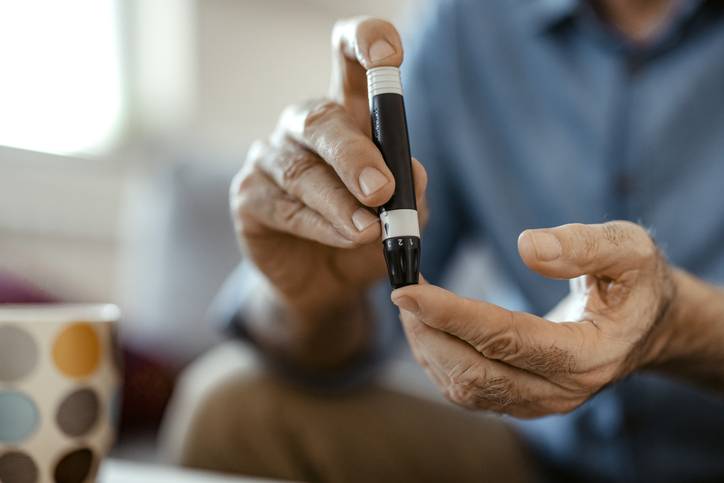Among NCDs is diabetes, which is likely to afflict 8.75 million people by 2040 and requires urgent government intervention
Non-communicable diseases (NCDs) — diabetes, hypertension, heart disease and cancer — are an escalating public health crisis in South Africa. The statistics speak for themselves.
NCDs accounted for the largest percentage of deaths in the country, according to the 2020 Statistics South Africa’s Mortality and Causes of Death in South Africa report, released in May this year.
Of the NCDs, diabetes — primarily Type 2, accounting for more than 90% of diabetes cases — is the number one killer. Although the leading cause of death in 2020 was Covid-19, accounting for 6.7% of deaths, it was followed closely by diabetes at 6.6%, according to the report. And diabetes was a major comorbidity accounting for Covid-19 deaths.
Percept, a South African consulting firm that used local data from population surveys and medical schemes, estimates that just under 5.6 million South Africans were living with diabetes in 2019, significantly higher than the figure of 4.2 million cited by the International Diabetes Federation. Based on its data, Percept forecasts that this number will rise to about 8.75 million in 2040.
Diabetes Type 2 is preventable and manageable, often to the point of being inconsequential for patients. Untreated, however, it undermines outcomes for other major conditions, including tuberculosis (TB), HIV, maternal and neonatal health, cardiovascular disease and chronic kidney disease.
The biggest driver of diabetes is obesity — caused mainly by poor lifestyle choices including fast-food diets, lack of exercise, smoking and alcohol abuse, which in itself is a national health crisis. Almost half the adult population of South Africa is overweight or obese, and childhood obesity rates are also on the rise, according to the Human Sciences Research Council’s National Food and Nutrition Security Survey, conducted from 2021 to 2023. This fits the global pattern of NCDs disproportionately affecting people in low- and middle-income countries.
Hypertension (high blood pressure), meanwhile, known as the silent killer (because most of its sufferers are unaware they have it), is estimated to affect one in three South Africans and is responsible for one in every two strokes, and two in every five heart attacks, according to the department of health.
And while hypertension and heart disease prevalence has been generally lower in rural than in urban populations, recent data shows that the gap is closing as rural populations also adopt unhealthy lifestyles, enabled by easier access to fast-food and liquor outlets.
These statistics bring into sharp focus the NCD pandemic, and the urgent need for the government to introduce integrated management strategies for the prevention, treatment and care of these diseases. Interventions are needed at all levels of the health system, from primary healthcare clinics and district and regional hospitals to academic hospitals. Intervention is also required in schools as part of the life orientation curriculum to raise awareness of the negative long-term health implications of poor nutrition. Refined carbohydrates should be heavily taxed to fund the costs that the state ultimately incurs to treat NCDs.
The imperative to do so is economic as well as philanthropic, given that the economic development of a nation is dependent on the health of its population.
The burden of NCDs on the national fiscus is eye-watering: the direct cost of diabetes to the health system is R2.7 billion, and this is only for those patients who are diagnosed. Obesity on its own was estimated in 2020 to be R33.194 million, according to a paper titled Estimating the Healthcare Cost of Overweight and Obesity in South Africa, published in Global Health Action in 2022.
NCDs that are not prevented, detected, diagnosed, treated and managed not only burden the health system, they also burden employers and undermine livelihoods. A breadwinner in a family whose diabetes has been diagnosed too late or has not been managed properly may develop diabetes-related complications and struggle to earn a living and support their family.
Although the government has pledged to enhance efforts to combat NCDs in its 2022-2027 National Strategic Plan (NSP) on Non-Communicable Diseases (NCDs), experts agree that the plan is short on detail when it comes to implementation. According to the Diabetes Alliance, there has been minimal advancement in setting up the necessary monitoring and surveillance systems to evaluate whether the NSP goals are being achieved.
“The public healthcare system remains disproportionately geared towards infectious diseases such as HIV and TB. This imbalance leaves NCDs underfunded and under-researched, leading to gaps in prevention, treatment, and management of diabetes,” says Dr Patrick Ngassa Piotie, chairperson of the Diabetes Alliance.
In a report handed to the health department on 6 August, the Diabetes Alliance listed some of the problems that impede optimal diabetes prevention and care — identified during its Diabetes Summit in November 2023, which included inputs from more than 20 diabetes experts from 21 local and international organisations — that it believes the government needs to address.
The first is low awareness about NCDs in the healthcare system and the public about the causes of these diseases (tobacco, harmful use of alcohol, unhealthy diet and physical inactivity). “By implementing the promotion of healthy diets and physical activity, as outlined in the World Health Organisation’s NCD intervention recommendations, South Africa can significantly improve public health outcomes and mitigate the socioeconomic impact of NCDs,” the report says.
The second is the absence of dedicated surveillance systems, resulting in an underestimation of the true extent of the diabetes burden. What you cannot measure you cannot manage. An integrated, digitised diabetes surveillance system would “seamlessly integrate with existing health information systems, and can provide real-time data on diabetes prevalence, risk factors, and outcomes, enabling targeted interventions and research initiatives”, the report says.
Gaps in diabetes care are cited as another problem, along with the lack of education of healthcare workers, which poses a “significant obstacle”, the report says. The expertise of both community health workers and clinical associates should be harnessed, which would enhance and expand access to care. “A comprehensive training programme should be developed to enhance the skills and knowledge of healthcare workers, including doctors, nurses, clinical associates, community health workers and others, in diabetes prevention, management and care,” it states.
New therapeutic options and devices should also be introduced into the public sector, the report recommends. Anecdotal evidence shows that public sector patients in some public health facilities still battle to get glucometers and strips they need to test their blood sugar regularly to manage their diabetes.
“To manage their disease, people with diabetes need to avoid the risk of hypoglycaemia (glucose levels below normal) or hyperglycaemia (glucose levels above normal), which can be life threatening. One of the challenges is the fact that glucometers need to have their batteries replaced routinely. These batteries are costly. Poor people can’t afford them,” says Alexandra van Essche, spokesperson for the Diabetes Alliance and has Type 1 diabetes.
“Insulin pumps and continuous glucose monitoring devices/apps have been a game-changer for people living with diabetes — but only for those that can afford them,” she adds.
The Diabetes Alliance recommends dedicated funding streams for diabetes prevention and control in national and provincial healthcare budgets, as well as leveraging The Global Fund grant allocation and the Health Promotion Levy as avenues for funding.
“Proactive investment in diabetes prevention and care could help alleviate the immense strain that diabetes and its complications will place on the healthcare system in the future,” states the report.
Similar to diabetes, effective control and treatment for hypertension begins with surveillance and monitoring. Again, the majority of South Africans cannot afford home blood pressure monitors or blood pressure screening at pharmacies, so blood pressure checks at clinics should be provided countrywide.
Examples of cost-effective practical approaches include the establishment of cardiovascular screening centres at all district clinics, where blood pressure is also tested; monthly screening drives at community centres and awareness campaigns at shopping centres.
Experts have long agreed that healthcare services for both NCDs and communicable diseases such as HIV should be integrated, which would mean people with diabetes, hypertension, HIV, cardiovascular diseases and cancer would receive all the treatment and care they need from fewer resources.
This would also improve the chances of NCDs being picked up early. For example, a patient with diabetes would be detected if a visit for HIV testing included a diabetes screening, and would reduce the load on healthcare facilities. In turn, the burden of NCDs on the national health budget would be reduced, along with the bonus of a healthier population.
Helen Grange is a writer and sub-editor for Good Governance Africa.





















Discussion about this post